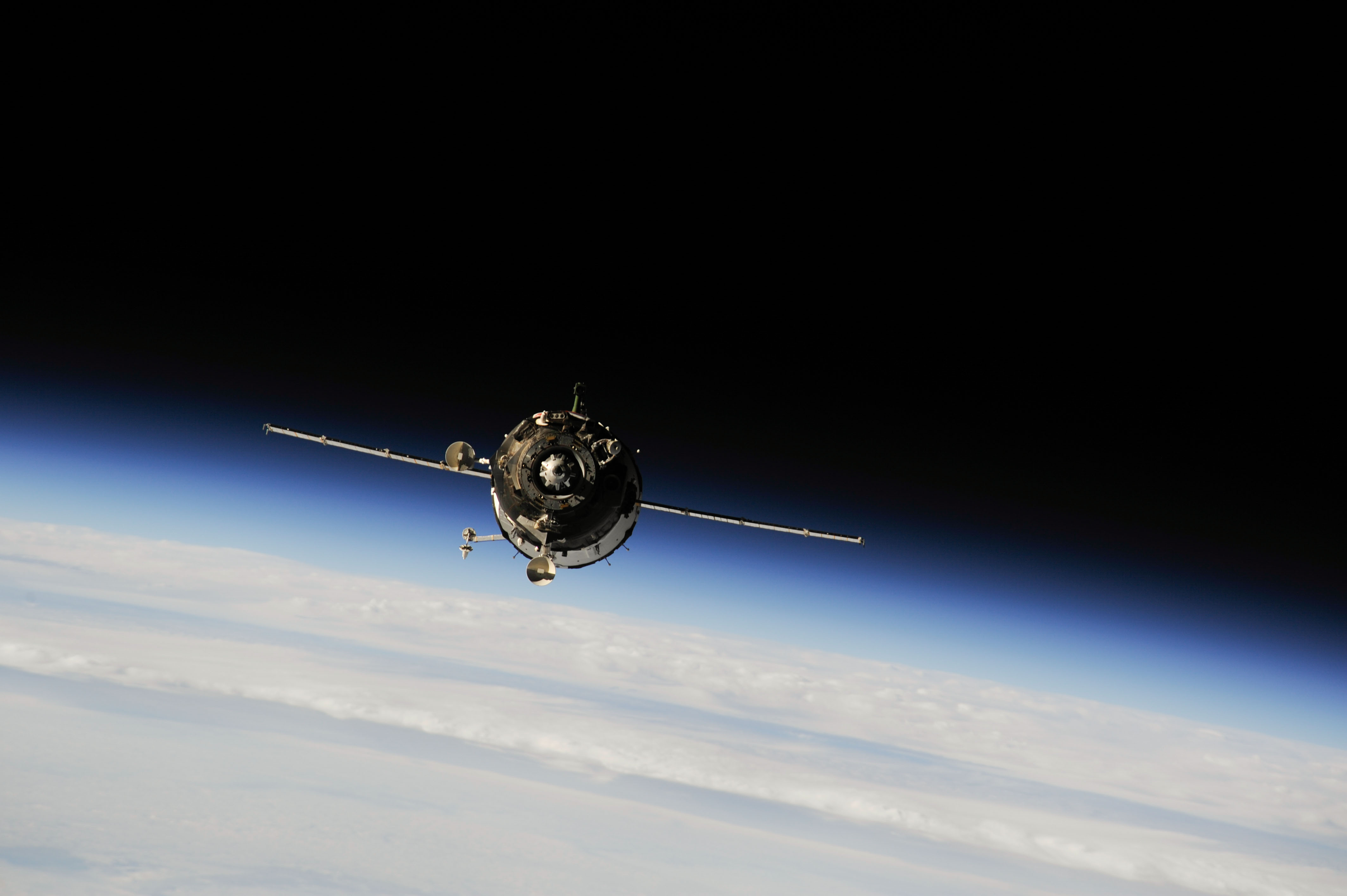
Like pieces on an orbiting chess board, Expedition 37 crew members Fyodor Yurchikhin, Karen Nyberg, and Luca Parmitano will board their Soyuz TMA-09M spacecraft tomorrow (Friday) and relocate it from the Earth-facing (or “nadir”) Rassvet module of the International Space Station (ISS) to the aft port of the Zvezda module. This will clear the way for the launch and arrival of Soyuz TMA-11M on 7 November, carrying Mikhail Tyurin, Koichi Wakata, and Rick Mastracchio. When combined with Soyuz TMA-10M’s Oleg Kotov, Sergei Ryazansky, and Mike Hopkins—who have been aboard the ISS since 25 September—the coming days will see the station population jump to nine members for the first time since the end of the shuttle era.
Tomorrow’s relocation has been made possible in the wake of last week’s undocking and departure of the Automated Transfer Vehicle (ATV)-4 “Albert Einstein,” a European Space Agency (ESA) cargo vehicle which launched and arrived at the station in June. The relocation plan calls for Soyuz TMA-09M to undock from Rassvet at 4:34 a.m. EDT Friday and undertake a short, 24-minute “hop” to the Zvezda aft port. In addition to reviewing procedures for the activity, on Monday, 28 October Yurchikhin, Nyberg, and Parmitano performed leak checks on their Sokol launch and entry suits, and on Tuesday, 29 October they ran through an on-board descent drill, reviewing emergency procedures and co-ordinating the items which they will bring back to Earth on 10/11 November.
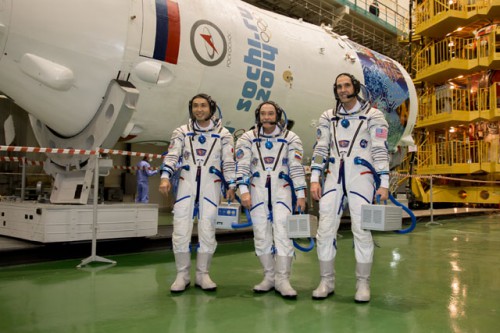
Under normal circumstances, six-person ISS expeditions follow an “indirect rotation” protocol, whereby a given three-member subset of the crew departs, temporarily reducing the station’s population to three, after which a new three-member crew arrives to boost it back up to six. This was the original plan for November, with Yurchikhin, Nyberg, and Parmitano scheduled to return to Earth on 10/11 November, after six months in orbit, leaving Kotov, Ryazansky, and Hopkins aboard the ISS for two weeks, until the launch of Tyurin, Wakata, and Mastracchio in late November.
However, that plan changed when it was decided to carry an Olympic torch—part of the relay in preparation for the 2014 Sochi Games—into orbit aboard Soyuz TMA-11M, ceremonially take it outside during a spacewalk by Kotov and Ryazansky, and then bring it back to Earth aboard Soyuz TMA-09M with Yurchikhin, Nyberg, and Parmitano. In order for this plan to work, all three Soyuz vehicles needed to be at the station simultaneously, and the launch of Tyurin’s crew was advanced by three weeks to 7 November. This will allow Kotov and Ryazansky to perform their highly symbolic spacewalk on 9 November, with the departure and return to Earth of the Soyuz TMA-09M crew (and the torch) slated for late the following night.
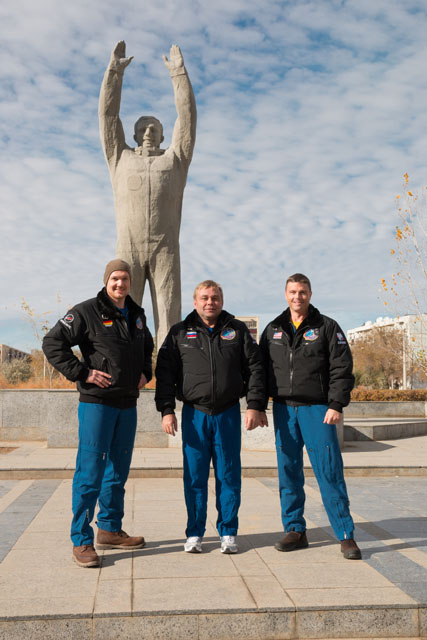
In readiness for their upcoming launch, Tyurin, Mastracchio, and Wakata completed their final Soyuz qualification exams at the Star City cosmonaut training center, near Moscow, on 15-18 October and flew to Baikonur in Kazakhstan on 26 October. In addition to the traditional raising of their national flags at the cosmodrome and fit checks of their Sokol launch and entry suits, the three men and their backup crew—Russian cosmonaut Maksim Surayev, NASA astronaut Reid Wiseman, and Germany’s Alexander Gerst—inspected the interior of the Soyuz TMA-11M spacecraft. Writing on Twitter, Gerst noted that the vehicle “has that typical, new-spaceship-smell that we all love.” The payload shroud for the rocket is also emblazoned with an artistic mural to commemorate the impending Sochi Games. Yesterday (Wednesday), NASASpaceflight.com reported that fueling of Soyuz TMA-11M with propellants and compressed gases had been completed and the three-part vehicle had been ensconced in the Spacecraft Assembly and Testing Facility for final processing operations. Next week, mounted atop its rocket (a direct descendent of the R-7 missile, created under the auspices of Chief Designer Sergei Korolev, back in the 1950s), Soyuz TMA-11M will be transported in a horizontal orientation to the launch pad.
Commanding Soyuz TMA-11M is 53-year-old Mikhail Tyurin, already a veteran of two previous long-duration expeditions to the ISS in August-December 2001 and September 2006-April 2007, and with more than a cumulative year of his life spent off the Home Planet. To him, the notion of flying the Olympic torch to the station is a peculiarity, but one which has given much cause for celebration as the world draws near to what Tyurin describes as “something that unites us.” He expects his crew to be a part of the Sochi Games, “not as participants,” but because they are an international team, whose principles closely mirror those of the Olympic athletes. “Some sport events teach us to value something great, something beautiful, something good, which becomes possible thanks to lots of work and effort from the athletes,” he explained in a pre-flight NASA interview. “I am not quite so interested in the winner, but I am interested in the achievement.”
Rick Mastracchio, also 53 years old, is a veteran of three shuttle missions, but this will be his first long-duration expedition to the ISS. “We knew everything that we were going to do before launch,” he told the NASA interviewer of the shuttle training mindset. “I had all my tasks memorized even before launch. As an expedition crew member, it is going to be quite different. Obviously, we’re going to have a series of tasks given to us by the ground folks, but we are not really going to know what it is until a week or so—or even a few days—before we get to do these things.” With an extra three weeks added to their mission, Mastracchio, Tyurin, and Wakata anticipate a return to Earth on 14 May 2014, producing a total duration of about 189 days—one of the longest in ISS program history. Asked for his thoughts about someday participating in a year-long expedition, like that planned for Scott Kelly and Mikhail Kornienko in 2015-2016, Mastracchio was both philosophical and pragmatic: “My goals here at NASA are to fly in space and do what the [Astronaut] Office asks of me,” he said, “so it would be a difficult mission … to be away from home for one year and it would be difficult on the body. But it would be difficult to turn it down!”

Rounding out the Soyuz TMA-11M crew is 50-year-old Koichi Wakata, the first Japanese astronaut to participate in two long-duration ISS expeditions and one of only four of his countrymen to spend a prolonged period of time aboard the space station. A veteran of three previous missions, Wakata will make history midway through his expedition, in mid-March 2014, when Soyuz TMA-10M returns to Earth with Kotov, Ryazansky, and Hopkins and he takes the helm of the ISS as its first Japanese commander. Paying tribute to the huge success of Japan’s Kibo laboratory complex and its H-II Transfer Vehicle (HTV) “Kounotori” (“White Stork”) cargo ship, Wakata is convinced that his homeland has established itself as a reliable partner in the ISS program. “As a partner of that program,” he said, “Japan will be happy to see its own representative command the space station. I am just very fortunate to be able to serve as the first Japanese space station commander.”
After launch from Baikonur, which is presently scheduled for 10:14 a.m. local time on 7 November (11:14 p.m. EST on 6 November), Soyuz TMA-11M will follow a now-standard flight profile to reach the ISS in just six hours and four orbits of Earth. First trialed by an unmanned Progress cargo vessel in August 2012, and then by the crew of Soyuz TMA-08M in March 2013, it is believed that getting crews to the station in a matter of hours—rather than the previous two-day rendezvous profile—is far better in terms of helping them to adapt to the microgravity environment and offset the risks of nauseous “space sickness.” After arriving at the ISS at 4:31 p.m. Baikonur time (5:31 a.m. EST) on 7 November, standard pressure and leak checks will be performed, ahead of opening the hatches between the Soyuz and the space station.
There will be little time for acclimatization, for Kotov and Ryazansky are scheduled to perform their EVA on 9 November and Yurchikhin, Nyberg, and Parmitano are due to undock their Soyuz TMA-09M spacecraft and return to Earth on 11 November. Often left unnoticed is that for those handful of days, Fyodor Yurchikhin will become the first ISS commander to lead a nine-person expedition. With four Russians (himself, Kotov, Ryazansky, and Tyurin), three Americans (Nyberg, Hopkins, and Mastracchio), one Italian (Parmitano), and a Japanese (Wakata), it promises to be one of the most racially and ethnically diverse crews since the end of the shuttle era. The previous record was a crew of eight, back in early October 2009, when Gennadi Padalka commanded the Expedition 20 crew of Russian cosmonauts Roman Romanenko and Maksim Surayev, together with Canada’s Bob Thirsk, Belgium’s Frank de Winne,and NASA astronauts Mike Barratt, Nicole Stott, and Jeff Williams.
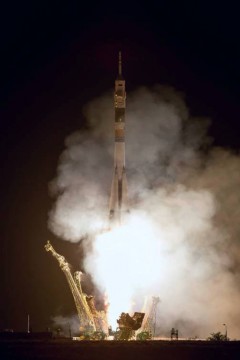
“I’ve been calling it Expedition 37.5,” joked Mastracchio in his pre-flight interview, “kind of to split the difference. Of course, when we arrive, it’s going to be a very hectic time. I imagine any time a new crew arrives, it is quite hectic, just trying to settle in, find our clothes and … everything that we’re going to need to live aboard space station.” If the Olympic torch is fulfilling part of its own relay, then Mastracchio certainly believes that the Expedition 37 crew will have their own relay going on in those few days. When he first learned that his crew would be carrying the Olympic torch with them, he contacted the U.S. Olympic team to ask if they wanted him to carry a banner into space. As a result, Mastracchio will be taking a banner, some patches, and a small stack of photographs of the athletes into orbit.
With the departure of Yurchikhin, Nyberg, and Parmitano on 10/11 November, Expedition 38 will officially commence, under the command of Oleg Kotov. This expedition will then run until mid-March 2014, when Kotov’s crew will return to Earth and Wakata will take command, kicking off Expedition 39. This period was originally scheduled to include the arrival of Russia’s long-delayed Multi-Purpose Laboratory Module (MLM), planned for December 2013, but since postponed again until April and later September 2014. However, its launch has reportedly been delayed until at least September 2015. This means that a number of EVAs from the Russian segment of the station may now be either cancelled or assigned other tasks.
The continued delay to the MLM will prove greatly disappointing to the entire ISS Program and, certainly, to the Expedition 38 crew. “I was part of the first crew to enter the [Zvezda] service module in 2000,” reflected Mastracchio. “It would be great to be part of the first crew to enter the MLM in 2014.” It appears that none of the crew will get this chance, but a number of other visiting vehicles are anticipated, starting with a Russian Progress resupply craft in late November and ORB-1, the first dedicated Cygnus cargo ship from Orbital Sciences Corp., in mid-December. As part of its own commitment to NASA, through the Commercial Resupply Services (CRS) contract, SpaceX is expected to despatch its third dedicated Dragon mission to the ISS in February, followed by a fourth in late April.
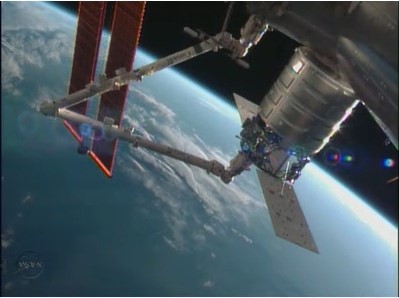
Both Cygnus and Dragon will be captured by means of the station’s 57-foot (17-meter) Canadarm2 robotic arm and berthed at the Earth-facing (or “nadir”) port of the Harmony node. According to Mastracchio, all members of the U.S. segment are fully trained to perform the capture, but “it’s really kind of a seniority thing,” with the most senior members of the crew overseeing each operation. Since Mike Hopkins has been aboard the ISS since late September, Mastracchio expects him to lead the ORB-1 capture and berthing in December. Subsequent operations—including the two Dragon berthings in February and April—he expects to be led by Wakata or himself.
For Wakata, becoming the first Japanese ISS commander in March 2014, following the departure of Kotov, Ryazansky, and Hopkins, is not expected to change much in his daily activities: “I will continue the duties that I have conducted as a flight engineer,” he said, “like conducting experiments, doing the maintenance tasks, robotics operations or spacewalks or any task that I am assigned to. In addition to that, I will be taking the lead as the point of contact in the communications, daily and weekly, with the Mission Control Centers throughout the world and also the program management of the International Space Station in the different countries. I just need to make sure that everybody in the crew is in healthy condition and safety comes first and efficiency and also the happiness of the crew members. I would like to make sure that we always work as an integrated team to be able to utilize the expertise, talent and also enthusiasm of all the crew members that we work with. I’m just fortunate to be able to fly with such talented and dedicated crew members.”
Want to keep up-to-date with all things space? Be sure to “Like” AmericaSpace on Facebook and follow us on Twitter: @AmericaSpace




One Comment
One Ping
Pingback:Weekly Links